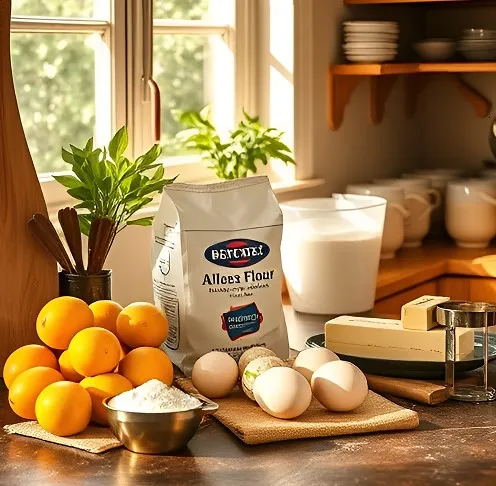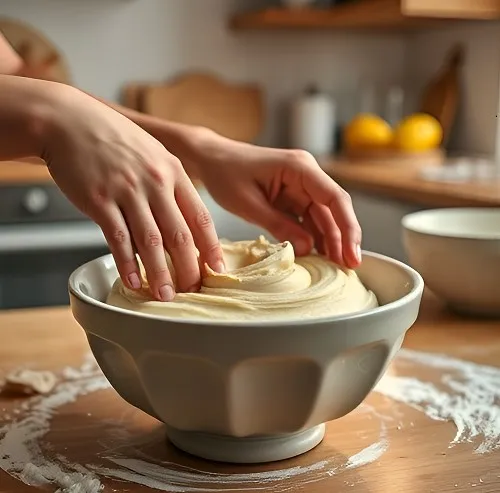Few treats can equal the charm and zest of Italian lemon cookies. Imagine biting into a tender, buttery cookie where the vibrant tang of freshly squeezed lemons meets a subtle sweetness that perfectly balances every flavor. These little treasures are more than just cookies; they are a slice of Italian culinary art steeped in tradition and crafted with passion. In this post, we dive deep into the world of Italian lemon cookies—from their historical roots and cultural significance to a step-by-step guide on creating your own batch at home. Whether you are a seasoned baker or simply looking to try something new, this exploration promises to offer insights, creative twists, and practical tips to enhance your baking journey
Table of Contents
A Taste of Tradition: The Story Behind Italian Lemon Cookies
Italian cuisine is renowned for its ability to weave simple ingredients into extraordinary experiences. Italian lemon cookies, often affectionately known as Biscotti al Limone, have enjoyed a longstanding reputation as a festive treat. Their origins trace back to regions where lemon orchards flourish—places like the sun-dappled hills of Sicily or the dramatic Amalfi Coast. In these locales, lemons have long been cherished not only for their flavor but also for their symbolic representation of brightness and renewal.
The tradition of baking lemon-infused treats spans several centuries, reflecting the Italian emphasis on using fresh, local produce. The natural acidity and aroma of lemons offer an ideal complement to rich, buttery dough, creating a delightful interplay of flavors that resonates with both young and old. Over time, Italian lemon cookies have evolved into a beloved delicacy often served at family gatherings, holiday feasts, and relaxing afternoon teas. Today, their enduring popularity speaks to the art of balancing simple ingredients to create a dessert that is both elegant and accessible.
The Essentials: Ingredients and Equipment for Perfection
Crafting the perfect Italian lemon cookie begins with quality ingredients and the right tools. The foundation of these cookies relies on a few essential elements that, when combined correctly, produce a harmonious symphony of flavors and textures.

The Core Ingredients
At the heart of the recipe are ingredients that are both straightforward and inspiring. A reliable all-purpose flour forms the backbone of the cookie’s structure. Pair this with granulated sugar, which not only sweetens the dough but also contributes to a subtly crisp exterior. High-quality butter is indispensable—it lends a rich, tender crumb that makes each bite melt in your mouth. Eggs serve a dual purpose, binding the ingredients and introducing a luxuriously smooth consistency.
The star product, however, is the lemon. Fresh lemon zest and juice are crucial, infusing the dough with a bright, tangy note that defines these cookies. A modest helping of baking powder ensures a delicate rise, while a pinch of salt helps to elevate the overall flavor complexity. Each component plays its role, and together they create a cookie that is both balanced and brilliant.
Essential Equipment for a Smooth Baking Experience
While the ingredients might be simple, the proper equipment can transform your baking session into a smooth, enjoyable experience. Begin with a few robust mixing bowls for combining your ingredients. Precision is key Italian Lemon Cookies, so employing quality measuring utensils is a must. Whether you’re using an electric mixer or a stand mixer, ensuring that your butter and sugar are creamed to perfection can make all the difference.
Your baking sheet should be sturdy and reliable, and lining it with parchment paper will prevent sticking and facilitate effortless cleanup. Finally, a cooling rack is beneficial once the cookies emerge from the oven, ensuring they retain their texture as they cool and set.
Crafting the Perfect Dough: A Step-by-Step Guide
Baking Italian lemon cookies is as much a labor of love as it is a practical exercise in culinary precision. Each phase of the process demands attention and care, from mixing the ingredients to applying the final glaze. Here’s how to create your own batch of Italian lemon cookies that will be the envy of any dessert table.
Bringing the Dough Together
Begin by preheating your oven to 350°F (175°C). Meanwhile, prepare your work surface by gathering all your necessary ingredients. Your first task is to cream the butter and sugar together. Use softened butter—this is crucial, as overly melted butter can hamper the texture of your dough. Beat these ingredients until they form a light, fluffy mixture that promises a tender outcome.
Once your butter and sugar are well-combined, add the eggs one at a time. This gradual incorporation ensures that the mixture remains smooth and even. With the eggs fully integrated, it’s time to introduce your lemon components. The freshly grated lemon zest and a generous squeeze of fresh lemon juice not only add flavor but also impart an aromatic quality that is unmistakably Italian.
While the lemon works its magic on the dough, whisk together your all-purpose flour, baking powder, and salt in a separate bowl. Combining these dry ingredients helps to distribute the leavening agent evenly throughout the dough, ensuring a consistent rise in every cookie. Gently fold the dry mixture into the wet ingredients, taking care not to overmix. Overworking the dough can lead to a denser cookie, so aim for a uniform but light blend.

Shaping and Baking: Turning Dough into Delight
With your dough complete, the next step is shaping it for baking. Using a cookie scoop or rolling your dough into small, even balls by hand ensures that each cookie bakes uniformly. Arrange your dough balls on a baking sheet lined with parchment paper, giving each a bit of room to expand during the baking process.
Slide the sheet into your preheated oven and let the cookies bake for approximately 10 to 12 minutes. Your goal is to achieve a delicate balance—the edges should develop a slight golden hue while the center remains tender and soft. It’s critical to keep an eye on the cookies during this window, as even an extra minute in the oven could alter their beloved texture.
The Finishing Flourish: Creating a Zesty Lemon Glaze
No Italian lemon cookie is truly complete without the signature lemon glaze that adorns its top. This glaze not only adds an extra burst of lemon flavor but also gives the cookie an appealing, glossy finish that catches the eye.
Whipping Up the Glaze
To prepare the glaze, sift a generous amount of powdered sugar into a bowl. Slowly incorporate fresh lemon juice, stirring continuously until you achieve a smooth, pourable consistency. The ratio of sugar to lemon juice can be adjusted based on your taste preference—if you like it extra zesty, add a bit more juice; if you prefer a sweeter top layer, lean on the powdered sugar.
When your cookies have cooled completely on the rack, use a spoon or a small piping bag to drizzle the glaze over each cookie. The glaze will settle into the crevices and add a subtle crunch as it sets, creating a delightful contrast with the soft, buttery base of the cookie.
A World of Variations: Tailoring Italian Lemon Cookies to Every Taste
One of the most delightful aspects of Italian lemon cookies is their versatility. While the classic recipe is a testament to Italian culinary tradition, there are numerous variations that allow you to experiment and adapt the Italian Lemon Cookies to meet dietary needs or creative desires.
Exploring Gluten-Free Options
For those who must avoid gluten, you can easily modify the recipe by substituting the all-purpose flour with a well-balanced gluten-free blend. Look for a mix that contains a binding agent like xanthan gum, which helps mimic the texture of traditional wheat flour. The outcome is a gluten-free cookie that retains the same delicate flavor profile and delightful bite as its classic counterpart.
Vegan Variations for a Plant-Based Twist
Vegan baking opens another exciting chapter in the realm of Italian lemon cookies. Replace the butter with a plant-based alternative such as vegan margarine or coconut oil, and swap eggs for flax eggs—simply mix 1 tablespoon of ground flaxseed with 3 tablespoons of water per egg. These substitutions not only honor vegan dietary choices but also offer a slightly different texture that still honors the bright lemon flavor so integral to the recipe.
Infusing Floral Aromas: Lemon and Lavender Cookies
For those looking to infuse a modern twist into a classic, consider adding a hint of dried lavender flowers to your dough. Lavender pairs wonderfully with lemon, offering a subtle floral note that elevates the cookie to a sophisticated treat perfect for special occasions or an elegant afternoon tea. Just be cautious with the amount—a little lavender goes a long way in balancing the bold citrus flavor.
Serving and Storing: Savoring Every Moment
Italian lemon cookies are as versatile in presentation as they are in flavor. Their bright, citrus-forward appeal makes them a perfect choice for various occasions—from everyday indulgences to celebratory events.
Serving Ideas for Every Occasion
Enjoying these cookies is a sensory delight no matter how you serve them. Imagine an intimate afternoon tea paired with a steaming mug of your favorite brew, where each bite of the cookie is a burst of sunshine. At holiday or family gatherings, these cookies can serve as the charming centerpiece on dessert tables, drawing compliments for both their taste and aesthetic appeal. They also make thoughtful homemade gifts, especially when packed in decorative tins or gift boxes that reflect the warm Italian heritage.
For the perfect hosting experience, serve these cookies on a rustic wooden tray or a ceramic plate that complements their vibrant color. Their presentation, combined with the tactile joy of biting into a crisp-edged and yet tender cookie, promises an elevated user experience that delights guests of all ages.
Keeping Your Treats Fresh
A common concern with homemade baked goods is how to maintain their freshness. Italian lemon cookies fare best when stored in airtight containers. If you plan to enjoy them within a couple of weeks, keeping them in a cool, dry place at room temperature helps preserve their texture and flavor. For longer storage, consider placing the cookies in zip-top freezer bags. When you’re ready to indulge again, simply thaw them at room temperature, and they’ll be just as satisfying as the day they were baked.

Health Benefits and Nutritional Insights
It might seem surprising, but these cookies offer more than just a sensory pleasure—they also incorporate the wholesome benefits of fresh lemon. Lemons are celebrated for their high vitamin C content and antioxidant properties, contributing to a healthful boost even in a treat that is inherently indulgent. Of course, moderation remains key.
Nutritional estimates for each cookie indicate a balance of roughly 100 to 120 calories, with approximately 15 grams of carbohydrates, 5 grams of fat, and 1 to 2 grams of protein per serving. While these cookies aren’t a health food per se, the inclusion of fresh citrus gives them an edge over some other sweets; the vitamin C and antioxidants from the lemon zest and juice can offer a small benefit alongside their delightful taste.
Frequently Asked Questions:
Experience in the kitchen naturally leads to questions and the need for small adjustments. Here, we address some of the most common queries—and concerns—that arise when baking Italian lemon cookies, ensuring that your next batch turns out flawlessly.
What Sets Italian Lemon Cookies Apart?
The unique spark in these cookies comes primarily from the fresh lemon zest and juice interwoven throughout the dough. This combination creates a pronounced tang that is unusual in its balance with a sweet, buttery base. Beyond the flavor, the texture of these cookies is remarkably light, offering a subtle crispness on the edges with a tender, almost melt-in-your-mouth center that distinguishes them from many other types of cookies.
Can I Use Bottled Lemon Juice as a Substitute?
Although bottled lemon juice might be a convenient option, fresh lemon juice is irreplaceable when it comes to capturing the true vibrancy of this treat. Fresh lemons provide a brightness and depth of flavor that bottled alternatives typically lack due to preservatives and diminished aroma. If you’re in a pinch, bottled juice can work, but for the most authentic taste, always opt for the freshly squeezed kind.
Why Might My Cookies Turn Out Flat?
Several factors can lead to cookies that fail to achieve the desired shape and texture. Overmixing the dough is a frequent culprit; once you’ve combined the ingredients, it’s best to mix just until everything is incorporated. Another factor could be inaccurate measurements—especially of leavening agents like baking powder—or using butter that is too soft or largely melted rather than simply softened. By ensuring careful measurements and a gentle mixing process, you can maintain the structure and lightness that truly characterize these cookies.
How Should I Store These Delights to Keep Them Fresh?
Proper storage is essential if you want your cookies to maintain their texture and flavor. An airtight container stored at room temperature will typically keep them fresh for up to two weeks. If you need to extend their shelf life, freezing them in a zip-top bag can preserve their quality for up to three months. When you’re ready for a treat, the cookies can be unfrozen at room temperature, and they’ll still have that wonderful balance of crisp edges and tender centers.
Final Thoughts: Bringing a Slice of Italy into Your Home
Italian lemon cookies embody the spirit of Italy—simple ingredients transformed by skill and passion into something utterly delightful. They remind us that great baking does not necessarily demand complex extras; rather, it relies on the pure, vibrantly fresh ingredients and the loving craftsmanship behind every recipe. These cookies can easily become a treasured part of your culinary repertoire, ideal for everyday enjoyment or for marking special moments with your loved ones.

